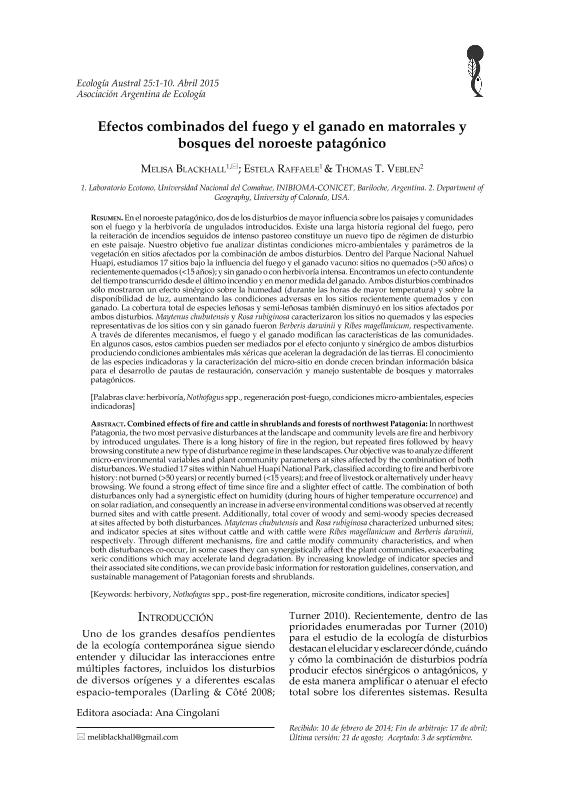Artículo
En el noroeste patagónico, dos de los disturbios de mayor influencia sobre los paisajes y comunidades son el fuego y la herbivoría de ungulados introducidos. Existe una larga historia regional del fuego, pero la reiteración de incendios seguidos de intenso pastoreo constituye un nuevo tipo de régimen de disturbio en este paisaje. Nuestro objetivo fue analizar distintas condiciones micro-ambientales y parámetros de la vegetación en sitios afectados por la combinación de ambos disturbios. Dentro del Parque Nacional Nahuel Huapi, estudiamos 17 sitios bajo la influencia del fuego y el ganado vacuno: sitios no quemados (>50 años) o recientemente quemados (<15 años); y sin ganado o con herbivoría intensa. Encontramos un efecto contundente del tiempo transcurrido desde el último incendio y en menor medida del ganado. Ambos disturbios combinados sólo mostraron un efecto sinérgico sobre la humedad (durante las horas de mayor temperatura) y sobre la disponibilidad de luz, aumentando las condiciones adversas en los sitios recientemente quemados y con ganado. La cobertura total de especies leñosas y semi-leñosas también disminuyó en los sitios afectados por ambos disturbios. Maytenus chubutensis y Rosa rubiginosa caracterizaron los sitios no quemados y las especies representativas de los sitios con y sin ganado fueron Berberis darwinii y Ribes magellanicum, respectivamente. A través de diferentes mecanismos, el fuego y el ganado modifican las características de las comunidades. En algunos casos, estos cambios pueden ser mediados por el efecto conjunto y sinérgico de ambos disturbios produciendo condiciones ambientales más xéricas que aceleran la degradación de las tierras. El conocimiento de las especies indicadoras y la caracterización del micro-sitio en donde crecen brindan información básica para el desarrollo de pautas de restauración, conservación y manejo sustentable de bosques y matorrales patagónicos. In northwest Patagonia, the two most pervasive disturbances at the landscape and community levels are fire and herbivory by introduced ungulates. There is a long history of fire in the region, but repeated fires followed by heavy browsing constitute a new type of disturbance regime in these landscapes. Our objective was to analyze different micro-environmental variables and plant community parameters at sites affected by the combination of both disturbances. We studied 17 sites within Nahuel Huapi National Park, classified according to fire and herbivore history: not burned (>50 years) or recently burned (<15 years); and free of livestock or alternatively under heavy browsing. We found a strong effect of time since fire and a slighter effect of cattle. The combination of both disturbances only had a synergistic effect on humidity (during hours of higher temperature occurrence) and on solar radiation, and consequently an increase in adverse environmental conditions was observed at recently burned sites and with cattle present. Additionally, total cover of woody and semi-woody species decreased at sites affected by both disturbances. Maytenus chubutensis and Rosa rubiginosa characterized unburned sites; and indicator species at sites without cattle and with cattle were Ribes magellanicum and Berberis darwinii, respectively. Through different mechanisms, fire and cattle modify community characteristics, and when both disturbances co-occur, in some cases they can synergistically affect the plant communities, exacerbating xeric conditions which may accelerate land degradation. By increasing knowledge of indicator species and their associated site conditions, we can provide basic information for restoration guidelines, conservation, and sustainable management of Patagonian forests and shrublands.
Efectos combinados del fuego y el ganado en matorrales y bosques del noroeste patagónico
Título:
Combined effects of fire and cattle in shrublands and forests of northwest Patagonia
Fecha de publicación:
2015
Editorial:
Asociación Argentina de Ecología
Revista:
Ecología Austral
ISSN:
1667-782X
e-ISSN:
0327-5477
Idioma:
Español
Tipo de recurso:
Artículo publicado
Clasificación temática:
Resumen
Archivos asociados
Licencia
Identificadores
Colecciones
Articulos(INIBIOMA)
Articulos de INST. DE INVEST.EN BIODIVERSIDAD Y MEDIOAMBIENTE
Articulos de INST. DE INVEST.EN BIODIVERSIDAD Y MEDIOAMBIENTE
Citación
Blackhall, Melisa; Raffaele, Estela; Veblen, Thomas T.; Efectos combinados del fuego y el ganado en matorrales y bosques del noroeste patagónico; Asociación Argentina de Ecología; Ecología Austral; 25; 1; -1-2015; 1-10
Compartir




